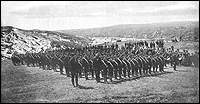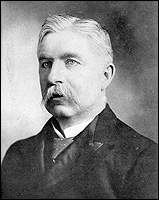Managing the
War Effort

|


|

|

Managing the War Effort
When war broke out on August 4, 1914, the Newfoundland government faced what was in many
respects a management problem. Men were wanted. Since Newfoundlanders were chronically
underemployed, men could be supplied. A decision to raise 500 soldiers for overseas duty plus a
home defence force to furnish reserves was announced within four days.
How the government of Prime Minister Edward P. Morris could enlist, train and equip
these men was not immediately apparent. The last British soldier had left in 1870 and no local
militia had emerged in the meantime. The government had no military department, nor
experienced civil servants to spare. It had few financial resources. Aside from a branch of the
Royal Naval Reserve, in St. John’s there were four church-sponsored cadet corps, a branch of the
non-denominational Legion of Frontiersmen, and a rifle club.
Church Lads’ Brigade drilling on Signal Hill, St. John’s, ca. 1910.
Courtesy of the Provincial Archives of Newfoundland and Labrador (PANL VA-33-71), St. John’s,
Newfoundland.
 (46 Kb)
(46 Kb)
|
 |

|
Apart from the lack of military expertise, Morris’ hold on the electorate was shaky. His
People’s Party had won only 41 percent of the popular vote in the 1913 election, and its support was
regionally and denominationally based. It was obvious that in order to raise a military force the
government would need the support of both opposition parties, Liberal and Union, and the three
church leaders, Anglican, Methodist and Roman Catholic.

|
 |
Sir Edward Morris.
Courtesy of the Provincial Archives of Newfoundland and Labrador (PANL VA-33-59), St. John’s,
Newfoundland.
 (16 Kb)
(16 Kb)
|
Morris was confident his government could meet its commitment. Newfoundlanders—at
least those in St. John’s and surrounding areas—supported the war effort, and not to answer
Britain’s call was inconceivable. Governor Sir Walter Davidson was prepared to take the lead,
with Morris working behind the scenes. At a public meeting on August 12, Davidson established
himself as head of what became the Newfoundland Patriotic Association (NPA). This was a non-partisan,
extra-parliamentary body which quickly grew from its original 55 St. John’s members to
300 island-wide. Its initial purpose was to raise and equip a military force of 500 men plus
reserves. After that, its responsibilities grew to encompass most aspects of the war effort. Various
committees did most of the work, but major decisions had first to be approved by the NPA, the
prime minister and opposition leader J. M. Kent (later William F. Lloyd).
Governor Davidson with wife and guests, St. John’s, n.d.
Courtesy of the Provincial Archives of Newfoundland and Labrador (PANL C 3-7), St. John’s,
Newfoundland.
 (20 Kb)
(20 Kb)
|
 |

|
The NPA managed the war effort for nearly three years, with generally good results. It
was a complex but flexible arrangement that drew on available military, business and professional
expertise, enjoyed the support of those who most counted, and kept potentially disruptive forces
at bay. But by the spring of 1917 it was clear that if the Newfoundland Regiment was to be
maintained as a fighting force, the colony’s elected representatives had to do more, particularly
with respect to recruitment. In July 1917 the National (coalition) Government was created, which
included a Department of Militia.
As the department gradually took over the various war-related tasks, the NPA faded into
the background. At the end of hostilities it resurfaced to address the question of a war memorial.

|

|
 |